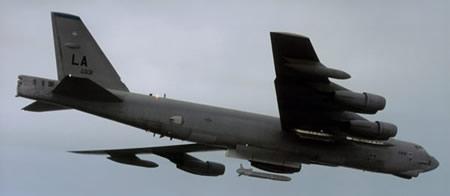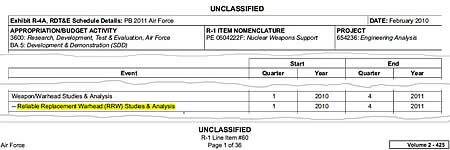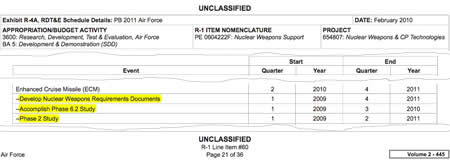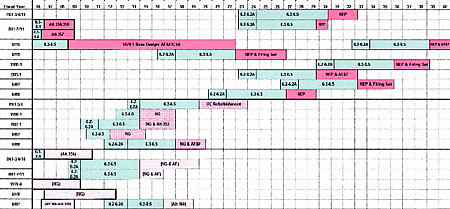Testing the No-New-Nuclear-Weapons Pledge
 |
| The Air Force is considering a replacement for the nuclear air-launched cruise missile. Will the NPR agree or adhere to Barack Obama’s no-new-nuclear-weapons pledge? |
.
By Hans M. Kristensen [updated March 18, 2010]
One of the important tests of Obama Administration’s nuclear nonproliferation policy will be whether the long-delayed Nuclear Posture Review will approve new nuclear weapons.
During his election campaign, Barack Obama promised not to build new nuclear weapons, a pledge that recently has been reiterated by the administration.
Yet the Air Force’s budget request for 2011 includes several projects that, if approved, would contradict the pledge.
The “No New” Pledge
During the presidential election campaign, Barack Obama pledge to “stop the development of new nuclear weapons” if elected president. The pledged lived on for the first few months after the election on the Obama administration’s White House foreign policy web page, but disappeared when the page was reorganized at the time of the Prague speech in April 2009.
Since the, the president has, to my knowledge, not repeated the pledge. But Under Secretary of State Ellen Tauscher echoed the election pledge last month when she explained that the Pentagon says it does “not need new nuclear weapons capabilities. They just want to be confident in what we have,” she said and declared: “We are not in the business of seeking new nuclear capabilities. They are not needed to preserve a strong, credible deterrent.”
New Nuclear Weapons
Yet “new” seems to be an elusive term. Even though Tauscher promised that the “RRW is dead and is not coming back,” the Air Force nuclear weapons support program includes “Reliable Replacement Warhead (RRW) Studies & Analysis” in both 2010 and 2011. Perhaps she meant RRW as it was known rather than ruling out future replacement warheads. [Update March 18, 2010: The US Air Force now says the reference to RRW studies and analysis is an error and that the item mistakenly was left in the budget request from the previous year]
| More RRW Studies? |
 |
| Despite a promise that the “RRW is dead and is not coming back,” the Air Force budget request includes RRW studies and analysis in both 2010 and 2011. Click for larger version. |
.
Another apparent contradictions with the administration’s no new nuclear weapons pledge is a new nuclear cruise missile to replace the current Air Launched Cruise Missile (ALCM) that expires in 2030. The new weapon is known as the Enhanced Cruise Missile (ECM), and development of nuclear weapons requirements documents are planned for 2010 and 2011, along with a Phase 6.2 Study, also known as a Feasibility Study and Option Down Select study. [Update March 18, 2010: The US Air Force now says the reference to the ECM is an error and that the item mistakenly was left in the budget request from the previous year. But the reference to the LRSO is not an error]
| A New Nuclear Cruise Missile? |
 |
| The Air Force budget request includes what appears to be a replacement for the nuclear Air Launched Cruise Missile. Will the NPR approve? Click for larger version. |
.
The Enhanced Cruise Missile appears to be part of a program known as the Follow-On Long Range Stand-Off (LRSO) Vehicle to develop a replacement for the Air Launched Cruise Missile (ALCM).
The plan includes production of the Initial Capabilities Document (ICD) in early 2010, a Material Development Decision (MDD) in September 2010, and an Acquisition Decision in late 2011 or 2012. With that timeline, the NPR will have to make a decision.
New or Modified Warhead
One question is whether the new cruise missile will use a modified version of the existing W80-1 warhead currently deployed on the ALCM for B-52 delivery, or require development of a new warhead.
 |
| A W80-1 warhead is mated with an ALCM. |
Until 2006, a life extension program (LEP) existed to extend the life of the W80-1. The LEP version was called W80-3. A parallel program to extend the W80-0 warhead would have produced the W80-2. But the Bush administration decided to “defer” the programs in pursuit of the RRW. That effort failed but the W80 LEP is still “archived,” according to the Air Force FY2011 budget request.
The remaining W80-1 warheads are scheduled to receive new neutron generators in 2015-2017, but a refurbishment of the nuclear explosive package is not planned until 2036-2039, according to the NNSA’s FY09 refurbishment planning schedule (no schedule exists yet for FY2010 or FY2011). No life-extension is planned for the W80-0, which will be retired.
| Warhead Refurbishment Plan? |
 |
| The National Nuclear Security Administration’s nuclear warhead refurbishment plan does not include a formal life-extension program for the W80-1 warhead. An expensive program would be added if the NPR approves the Air Force’s cruise missile plan. Chart obtained under FOIA. Click for larger version. |
.
A decision to use a modified version of the existing W80-1 in the new cruise missile would involve reviving the $200 million per year W80-3 LEP program.
New or Just “New”
Nuclear weapons modernization programs risk triggering a contentious debate similar to the dispute over the RRW and whether Obama’s no-nuclear-weapons pledge can be trusted.
Does a new “weapon” refer to the warhead on the missile or the delivery vehicle itself or both? And how new must a weapon be to be considered “new” – does it require an entirely new design or can a modified design be considered a “new” weapon?
Government officials have to be crystal clear when they present the results of the NPR to make sure the administration’s nonproliferation policy doesn’t get stuck in the mud of misunderstandings and contradictions about what constitutes a “new” nuclear weapon. A lot is at stake.
Additional Information: Pentagon Eyes More Than $800 Million for New Nuclear Cruise Missile
This publication was made possible by a grant from Carnegie Corporation of New York and Ploughshares Fund. The statements made and views expressed are solely the responsibility of the author.
The FY2026 National Defense Authorization Act (NDAA) paints a picture of a Congress that is working to both protect and accelerate nuclear modernization programs while simultaneously lacking trust in the Pentagon and the Department of Energy to execute them.
While advanced Chinese language proficiency and cultural familiarity remain irreplaceable skills, they are neither necessary nor sufficient for successful open-source analysis on China’s nuclear forces.
Satellite imagery has long served as a tool for observing on-the-ground activity worldwide, and offers especially valuable insights into the operation, development, and physical features related to nuclear technology.
This report outlines a framework relying on “Cooperative Technical Means” for effective arms control verification based on remote sensing, avoiding on-site inspections but maintaining a level of transparency that allows for immediate detection of changes in nuclear posture or a significant build-up above agreed limits.